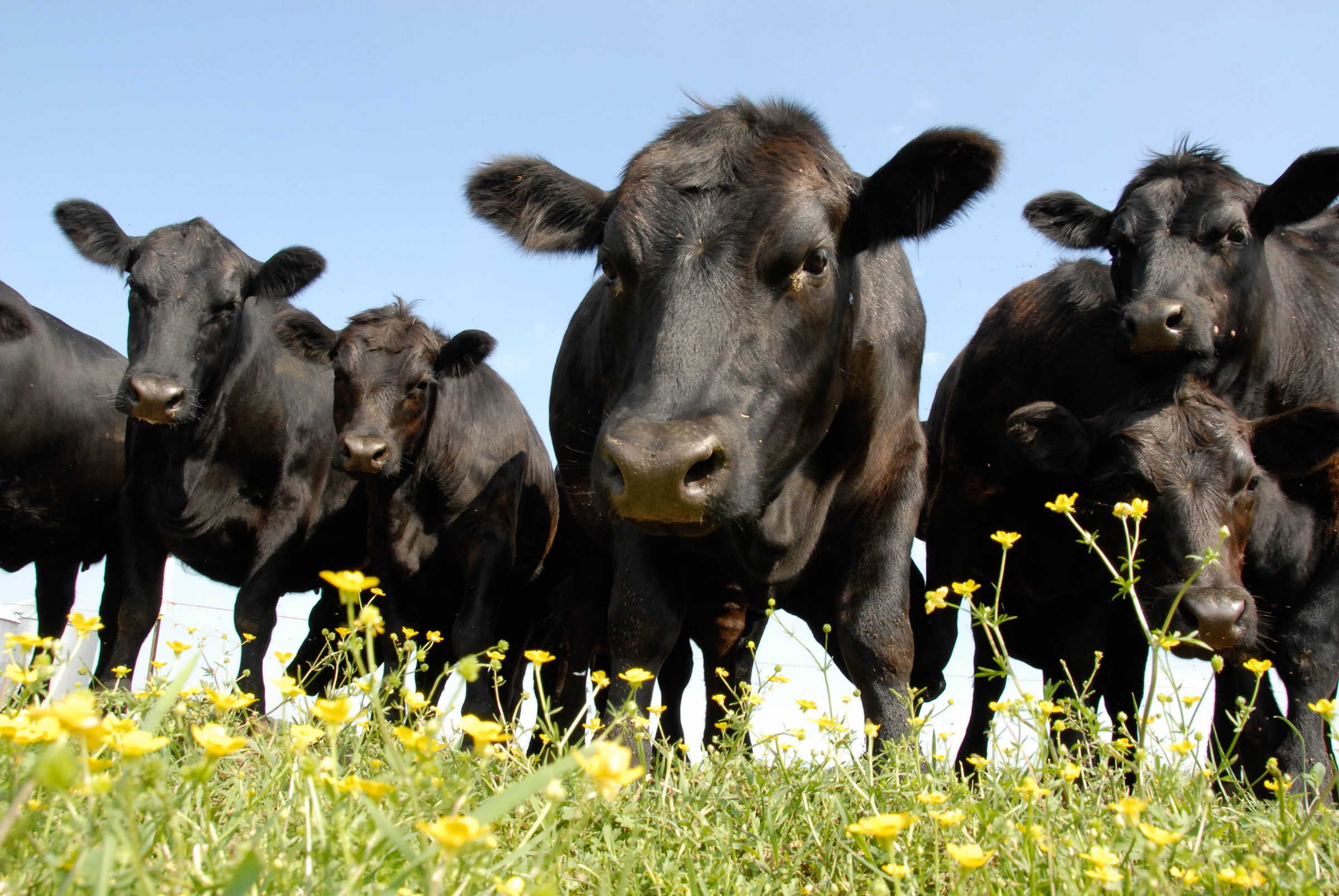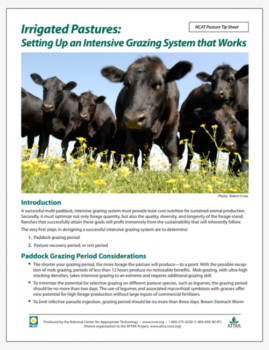Irrigated Pastures: Setting Up an Intensive Grazing System that Works

Black Angus and Buttercups at Crow Farm. Photo: Robert Crow
By Dave Scott, NCAT Livestock Specialist
Introduction
A successful multi-paddock, intensive grazing system must provide least-cost nutrition for high animal production. Secondly, it must optimize not only forage quantity, but also the quality, diversity, and longevity of the forage stand. Ranches that successfully attain these goals will profit immensely from the sustainability that will inherently follow.
The very first step in designing a successful intensive grazing system is to determine:
- Paddock grazing period
- Pasture-recovery period, or rest period
Paddock Grazing Period Considerations
- The shorter your grazing period, the more forage the pasture will produce—to a point. With the possible exception of mob grazing, periods of less than 12 hours produce no noticeable benefits. Mob grazing, with ultra-high stocking densities, takes intensive grazing to an extreme and requires additional grazing skill.
- To minimize the potential for selective grazing on different pasture species, such as legumes, the grazing period should be no more than two days. The use of legumes and associated mycorrhizal symbiosis with grasses offer new potential for high forage production without large inputs of commercial fertilizers.
- To limit infective parasite ingestion, grazing period should be no more than three days. Brown Stomach Worm and Barber Pole Worm eggs take four to six days to develop into infective larvae. A two-day grazing period is even better because you can control the height of the stubble more uniformly. Worm larvae typically migrate three to four inches up the plant stem.
- Grazing below the growing point of grass will result in one week of lost production. Two-day grazing periods limit this over-grazing. Learn the grazing point of your pasture species. One or two days of less fence moving at the cost of a week’s worth of production is not a good trade. For dairy, higher dry matter intake—and more milk—is achieved with 12-hour grazing periods.
- Don’t overlook the importance of labor. If you want the increased net income that results from an intensive grazing system, you must put in the time. Look elsewhere to reduce labor. Intensive grazing gives you more stockpiled winter pasture. Could you hay less?
Grazing Recovery Period Considerations
- In any particular region, the grazing recovery period will depend on the species of forage. For example, orchardgrass and meadow bromes need a minimum of 20 days of rest, and perennial ryegrasses need two weeks. If you disregard this need in temperate climates, you will lower production. In the Rocky Mountain West, the stand very well could suffer winter kill. Additionally, shorter rest periods (20 days) have higher nutrient uptake demands (hence, more added fertilization) than longer rest periods.
- Shorter rest periods tend to keep the forage vegetative and of higher feed quality.
- Legumes like longer rest periods. In temperate climes, you can get away with 20-day rest periods. In the Rocky Mountain West, legumes need 35 days minimum or the legume will suffer winter kill.
- In general, rest periods of 35 days allow cool-season forages to mature and fully recover. As long as this meets the grazing animal’s nutrient requirements, full plant recovery should be your goal. This positions you to achieve highest forage and animal production for least cost. Rest periods of 35 days produce about 15% to 20% less dry matter grass yields than 20-day periods. There is also a corresponding 25% decrease in plant nutrient uptake. Less nutrient demand combined with the use of long-lived legumes may allow a more sustainable production model.
- Intensely high production can only be sustained by high nutrient inputs. In these days of high fertilizer prices, you may reach a point of diminishing returns.
- For parasites, a 30- to 35-day rest period seems to limit infective larval survival as opposed to 20-day periods. This opens up the opportunity to effectively control parasites without the use of wormers.
Putting It All Together
- Start by determining your recovery-day period. This drives the system.
- Decide on your paddock grazing period. This drives you!
- Divide your pasture up into grazing paddocks:
Number of Paddocks = Recovery-Period Days ÷ Paddock Grazing Period Days + 1
Since few fields are perfectly uniform, you have to improvise. Make your best possible guess of the yield distribution in your pasture. Strive to size your paddocks so they will sustain your livestock for each grazing paddock time period. You may be off by a half day or so, but that is alright–you can make adjustments as you go. You will probably be able to come up with an average-size paddock. However, some of your paddocks may be larger and some a little smaller, depending on the estimated grass production in each paddock.
- Estimate your average daily dry matter production for each grazing month. For example, in the Rocky Mountain Northwest, typical dry matter production rates are:
May 75 pounds of dry matter/acre/day
June 80 pounds of dry matter/acre/day
July 85 to 90 pounds of dry matter/acre/day
August 75 pounds of dry matter/acre/day
This includes a 5-inch stubble left behind.
- Your initial stocking rate can be determined by:
Stocking Rate = The Lowest Dry Matter Production Rate X Total Acres
Daily Dry Matter Intake of Livestock
Example: How many cow-calf pairs can you run on 100 acres?
Assumptions:
-
- 1,200-pound cows consuming 3.25% (39 pounds) of their body weight in dry matter per day.
- A 35-day recovery period and a paddock grazing period of two days.
75 Pounds/Acre/Day X 100 Acres = 192 Cow-Calf pairs
39 Pounds Dry Matter Intake/Day
With a paddock grazing period of seven days, the same 100 acres would support only 150 to 155 pairs.
-
- In the Rocky Mountain Northwest, we know from experience that we can turn out half of the pairs when the forage dry matter is 800 pounds/acre (usually the first week in May). We must wait until the paddock production is 1,400 pounds of dry matter per acre before turning out the remaining pairs (usually 10 to 12 days later). Alternatively, we can turn out all cows when the forage dry matter is 1,200 pounds per acre. In a normal year, with production at 75 pounds/acre/day in May, we will have enough forage to sustain the cattle for the month of June and beyond.
- As long as your inputs (fertility, sunlight, soil moisture) are kept up, this system will sustain itself.
- You must constantly monitor the grass production that is ahead of you. Always maintain a grass gradient, or wedge. Typically, the grass gradient should range from five inches for the latest exited paddock to 24 to 32 inches for the presently occupied paddock.
- The use of “outs,” or emergency pastures, must be incorporated into the grazing plan in case grass production slows down due to below average temperatures in early spring, irrigation failures, or any other unforeseen events. Outs can be in the form of additional pastures or stored feed. Generally, seven to 10 days of planned emergency feeding is sufficient. Decreasing the pasture stocking rate is also an option, although it can be cumbersome moving cattle in and out of the grazing unit.
Record Yields
Measuring yields is essential. Employ a simple spreadsheet that records stocking-rate data and computes this information into pounds of dry matter production per acre. This enables you to forecast production dips and swells, perform year-to-year analysis, and fine-tune your grazing system for any class of livestock.
| 2013 GRAZING DATA MONTANA HIGHLAND LAMB | |||||||||||||
| DATE | PADDOCK | SHEEP WT | DM I/HD | NO HD | DMI GRAZING UNIT | DAYS IN PADDOCK | DM PER PADDOCK | PADDOCK ACRES | DM/ACRE | GRAZING DAYS | CYCLE DAYS | DM/ACRE PER DAY | NOTES |
| 5/7/2013 | N DITCH | 160 | 10 | 100 | 1000 | 6 | 6000 | 4 | 1500 | 1 | 6-8″, LAMB WT 25 LB | ||
| 5/13/2013 | E ELLEN | 160 | 10 | 200 | 2000 | 4 | 8000 | 4 | 2000 | 7 | |||
| 5/17/2013 | W ELLEN | 160 | 11 | 200 | 2200 | 3 | 6600 | 5 | 1320 | 11 | LAMB WT 30 LB | ||
| 5/20/2013 | W BARN | 160 | 11 | 200 | 2200 | 1 | 2200 | 1 | 2200 | 14 | 16″ | ||
| 5/21/2013 | ROAD | 160 | 11 | 200 | 2200 | 2 | 4400 | 1.5 | 2933 | 15 | |||
| 5/23/2013 | W BARN | 160 | 11 | 200 | 2200 | 4 | 8800 | 4 | 2200 | 17 | |||
| 5/27/2013 | E BARN | 160 | 12 | 200 | 2400 | 5.5 | 13200 | 6 | 2200 | 21 | 24″, LAMB WT 40LB | ||
| 6/2 AM | S DITCH | 160 | 12 | 200 | 2400 | 8 | 14400 | 4 | 3600 | 27 | 32″, 4500 # HAY SUPPLEMENTED | ||
| 6/10 pm | N DITCH | 160 | 12 | 200 | 2400 | 4 | 9600 | 4 | 2400 | 35 | 34 | 70.6 | 32″ RECOVERED |
| 6/14 PM | E ELLEN | 160 | 13 | 200 | 2600 | 4 | 10400 | 4 | 2600 | 39 | 32 | 81.3 | 32″ RECOVERED, LAMB WT 50 lb |
| 6/18 PM | W ELLEN | 160 | 13 | 200 | 2600 | 5 | 43 | 32 | 32″ RECOVERED | ||||
Summary
Designing and implementing an intensive grazing system is not as simple as just turning the cows out to pasture. An intensive grazing design is based on only three parameters: recovery period, grazing paddock period, and the growth rate of the forage. It requires a step up in management that is easily accomplished through the use of a grazing spreadsheet and field experience.
This grazing approach is not for everyone. However, if you can embrace and incorporate it into your ranch business plan, it will yield great benefits. It can double your increase your pasture yields two-fold while potentially decreasing—or perhaps, over time, even eliminating—purchased fertilizer inputs. This opportunity does not happen very often. Intensive grazing is one of the most powerful management strategies in agriculture today.
Irrigated Pastures: Setting Up an Intensive Grazing System that Works
By Dave Scott, NCAT Livestock Specialist
Published July 2013
©NCAT
IP456
This publication is produced by the National Center for Appropriate Technology through the ATTRA Sustainable Agriculture program, under a cooperative agreement with USDA Rural Development. ATTRA.NCAT.ORG.


